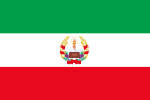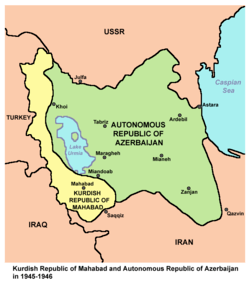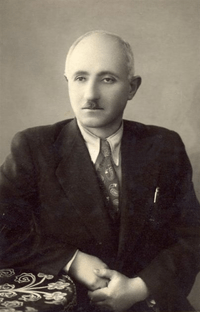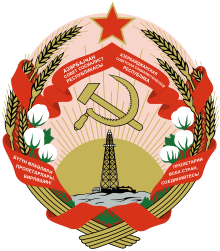Azerbaijan People's Government
| Azerbaijan People's Government | |||||||||
|---|---|---|---|---|---|---|---|---|---|
| 1945–1946 | |||||||||
 Flag
 Coat of arms
| |||||||||
| Status | Puppet state of the Soviet Union[1][2] | ||||||||
| Capital | Tabriz | ||||||||
| Common languages | Azerbaijani | ||||||||
| Government | Marxist-Leninist one-party state | ||||||||
| President | |||||||||
• 1945–46 | Ja'far Pishevari | ||||||||
| Historical era | Cold War | ||||||||
• Established | November 1945 | ||||||||
• Disestablished | December 1946 | ||||||||
| |||||||||
| Today part of |
| ||||||||


The Azerbaijan People's Government (APG; Azerbaijani: Azərbaycan Milli Hökuməti, Persian: حکومت خودمختار آذربایجان, Russian: Азербайджанское народное правительство, Azerbajdzhanskoe narodnoe pravitel'stvo) was a short-lived unrecognized secessionist state[4][5] in northern Iran from November 1945 to December 1946. Established in Iranian Azerbaijan, the APG's capital was the city of Tabriz. Its establishment and demise were a part of the Iran crisis, which was a precursor to the Cold War.
History
To supply the Soviet forces with war material through Iran, British and Soviet troops jointly occupied the country in August 1941.[6] Soviet forces entering Iranian territory from the Armenian SSR and the Azerbaijan SSR and British and Indian forces entering from Iraq soon took the control of the country.[7] On 16 September, the British forced Reza Shah, who had pro-Nazi sympathies, to abdicate in favor of his son Mohammad Reza Shah Pahlavi, who ruled until 1979.[7]
With the dethronement of Reza Shah in September 1941, Soviet troops captured Tabriz and northwestern Iran for military and strategic reasons. The Azerbaijan People's Government, set up by the Soviets, under leadership of Ja'far Pishevari was proclaimed in Tabriz in 1945.[7] Lavrenti Beria was nominally in charge of the operation, but delegated it to Mir Jafar Baghirov, the First Secretary of the Communist Party of Azerbaijan in Baku.[7] The Democratic Party of Azerbaijan was also created by the direct order of Joseph Stalin[8] and capitalized on some local people's dissatisfaction with the centralization policies of Reza Shah.[7] It was supplied with money and weapons by the USSR.[7] With northern Iran under Soviet occupation, Stalin made plans to "spread Socialism" by creating independent states and wanted to make pressure on Iran to get an oil concession in the southern part of Azerbaijan.[7] The Kurdish Republic of Mahabad was one such state and the Soviets decided to create a separate state for northern Iran's Azeri population as well. During this time, a revival of the Azerbaijani literary language, which had largely been supplanted by Persian, was promoted with the help of writers, journalists, and teachers from the Azerbaijan SSR. In the quest of imposing national homogeneity on the country where half of the population consisted of ethnic minorities, Reza Shah had previously issued in quick succession bans on the use of Azerbaijani language on the premises of schools, in theatrical performances, religious ceremonies, and, finally, in the publication of books.[9] These directives were issued despite the fact that Reza Shah's mother Noosh Afarin and his wife Taj-Al-Molook Ayrimlu were both of Azerbaijani descent.
Establishment
The Firqah-i Dimukrat, or Azerbaijani Democratic Party (ADP), publicly announced its formation in Tabriz on September 3, 1945 by a group of veteran communists headed by Ja'far Pishevari. After the announcement, the communist, Soviet-supported Tudeh party dissolved its Azerbaijan chapter and ordered its members to join ADP.[10] ADP expanded throughout Iranian Azerbaijan, and initiated a local coup d'état with help from Soviet army, who prevented the Iranian army from intervening.[11] During the first week of September 1945, the Azerbaijani Democratic Party, led by Ja'far Pishevari, a long-time leader of the revolutionary movement in Gilan, declared itself to be in control of Iranian Azerbaijan, promised liberal democratic reforms, and disbanded the local branch of Tudeh.[12][13] Later in September 1945, at its first congress, the Azerbaijani Democratic Party authorized the formation of a peasant's militia. This militia started a bloodless coup on November 18, 1945[14] and by November 21, 1945 they had captured all remaining government posts in the province, and Iranian Azerbaijan "became an autonomous republic under the direction of a 39-member national executive committee".[11][15] The reality of the power seems to have been exercised by Mohammed Biriya, the Minister of Propaganda and head of the local secret police.[7]
At the same time, the US was steadily increasing its military assistance to the Iranian government. Under pressure by the Western powers, the Soviet Union revoked its support of the newly created state and the Iranian military succeeded in re-establishing Iranian rule in November 1946. According to Tadeusz Swietochowski:
As it turned out, the Soviets had to recognize that their ideas on Iran were premature. The issue of Iranian Azerbaijan became one of the opening skirmishes of the Cold War, and, largely under the Western powers' pressure, Soviet forces withdrew in 1946. The autonomous republic collapsed soon afterward, and the members of the Democratic Party took refuge in the Soviet Union, fleeing Iranian revenge. In Tabriz, the crowds that had just recently applauded the autonomous republic were now greeting the returning Iranian troops, and Azerbaijani students publicly burned their native-language textbooks. The mass of the population was obviously not ready even for a regional self-government so long as it smacked of separatism.[16]
Soviet support
New declassified evidence of formerly top secret documents from the Cold War implicates the USSR in forming the government of Pishevari by the direct orders of Stalin.[8] The Soviet military supported the new autonomous entity and prevented the Iranian army from restoring governmental control over the area. After the Soviet withdrawal, Iranian troops entered the region in December 1946 and Pishevari and his cabinet fled to the Soviet Union.[17][18] According to Prof. Gary R. Hess:
On December 11, an Iranian force entered Tabriz and the Peeshavari government quickly collapsed. The Soviet willingness to forego its influence in (Iranian) Azerbaijan probably resulted from several factors, including the realization that the sentiment for autonomy had been exaggerated and that oil concessions remained the more desirable long-term Soviet Objective.[19]
Dissolution
On June 13, 1946, an agreement was reached between the Central Government [in Tehran] and the delegates from Azerbaijan, headed by Pishevari.[20] By that agreement, Pishevari agreed to abandon the APG's autonomy, to relinquish its ministries and premiership, and to become once more part of Iran. Its parliament was to be transformed into a provincial council - a system recognized and provided for in the Iranian Constitution.[20]
By mid-December 1946, the Iranian army, backed by the United States and the British,[21] reentered Tabriz, thus putting an end to Azerbaijan People's Government after a full year of its existence.[22] During the lawless interregnum, approximately 500 supporters[23][24] of the Ferqeh were killed. According to the U.S. Supreme Court Justice, William O. Douglas, while the Russian Army had been on its best behavior when stationed in Azerbaijan, the Iranian Army behaved as an occupying force and brutalized the local inhabitants. The beards of peasants were burned, their wives and daughters raped. Houses were plundered and livestock were stolen. The Army left a trail of death and destruction behind it.[25]
Many of the leaders took refuge in the Azerbaijan SSR. Ja'far Pishevari died in a car accident in Baku in 1947. Prime Minister Kordary was jailed for many years by the Shah and later released due to the tireless efforts of his brother Kazem.
See also
References
- ↑ Frederik Coene (2009), The Caucasus - An Introduction, Routledge Contemporary Russia and Eastern Europe Series, Routledge, p. 136, ISBN 9781135203023,
As a result, the People's Republic of Azerbaijan and the Kurdish People's Republic (the Republic of Mahabad), two short-lived Soviet puppet states, were set up late in 1945...
- ↑ Donald Newton Wilber (2014). Iran, Past and Present: From Monarchy to Islamic Republic. Princeton University Press. p. 136. ISBN 1400857473.
In December the Democratic Party of Azerbaijan, announced the establishment of an autonomous state of Azerbaijan, and at the same time the Russians set up another puppet state, the Kurdish Republic of Mahabad, also in Azerbaijan.
- ↑ The Kurdish Republic of Mahabad (author Archie Roosevelt, Jr.), p. 249. // Middle East Journal. Volume 1, № 3. Publisher: Middle East Institute. July 1947, 368 pages.
- ↑ Chelkowski, Peter J.; Pranger, Robert J. (1988). Ideology and Power in the Middle East: Studies in Honor of George Lenczowski. Durham: Duke University Press. ISBN 9780822307815. OCLC 16923212.
- ↑ Abrahamian, Ervand (1982). Iran Between Two Revolutions. Princeton, N.J.: Princeton University Press. ISBN 9780691053424. OCLC 7975938.
- ↑ Reza Shah Pahlavi :: Policies as shah. - Britannica Online Encyclopedia
- 1 2 3 4 5 6 7 8 Sebestyen, Victor (2014). 1946: The Making of the Modern World. Pan McMillan. ISBN 0230758002.
- 1 2 "1945-46 Iranian Crisis". Cold War International History Project. Woodrow Wilson International Center for Scholars.
- ↑ Tadeusz Swietochowski, Russia and Azerbaijan: A Borderland in Transition. ISBN 0-231-07068-3
- ↑ Iran in claws of the bear, The failed Soviet landgrab of 1946 , Farhad Tale, iUniverse books, 2007, ISBN 0-595-41345-5,p19
- 1 2 Abrahamian, Ervand (October 1970). "Communism and Communalism in Iran: The Tudah and the Firqah-I Dimukrat". International Journal of Middle East Studies (PDF)
|format=requires|url=(help). Cambridge, MA: Cambridge University Press. 1 (4): 291–316. doi:10.1017/s0020743800000702. JSTOR 162649. - ↑ Sepehr Zabih. The Communist Movement in Iran, Berkeley, 1966, p. 99
- ↑ Ervand Abrahamian. Iran between Two Revolutions, Princeton, 1982, pp. 217-218
- ↑ Jessup, John E. (1989). A Chronology of Conflict and Resolution, 1945-1985. New York: Greenwood Press. ISBN 0-313-24308-5.
- ↑ Fred H. Lawson. "The Iranian Crisis of 1945-1946 and the Spiral Model of International Conflict", International Journal of Middle East Studies, Vol. 21, No. 3. (Aug., 1989), p. 316
- ↑ Swietochowski, Tadeusz 1989. "Islam and the Growth of National Identity in Soviet Azerbaijan", Kappeler, Andreas, Gerhard Simon, Georg Brunner eds. Muslim Communities Reemerge: Historical Perspective on Nationality, Politics, and Opposition in the Former Soviet Union and Yugoslavia. Durham: Duke University Press, pp. 46-60.
- ↑ Azerbaijan Crisis (1947-1948)
- ↑ Iran in World War II Archived October 16, 2009, at the Wayback Machine.
- ↑ Gary. R. Hess Political Science Quarterly, Vol. 89, No. 1 (March., 1974)
- 1 2 A. C. Edwards. "Persia Revisited", International Affairs (Royal Institute of International Affairs 1944), Vol. 23, No. 1. (Jan., 1947), p. 58
- ↑ McEvoy, Joanne; O'Leary, Brendan (2013). Power Sharing in Deeply Divided Places. Philadelphia: University of Pennsylvania Press. p. 191. ISBN 9780812245011.
- ↑ George Lenczowski. "United States' Support for Iran's Independence and Integrity, 1945-1959", Annals of the American Academy of Political and Social Science, Vol. 401, America and the Middle East. (May, 1972), p. 49
- ↑ Swietchowski:"Addressing the troops entering Azerbaijan, General ‘Ali Razmara proclaimed that they were restoring the soul of Iran to the nation, and henceforth the anniversary of the event would be celebrated by a military parade. By all accounts the population’s enthusiastic welcome of the Iranian army was genuine. Among the elated throngs were many who barely a year ago had also enthusiastically greeted the rise of the Pishevari government; the change of heart was due not only to disenchantment with the Democrats but also the uncontrollable violence being meted out at the sympathizers of the fallen regime. Rossow conservatively estimated 500 killed during the lawless interregnum that preceded the coming of the Iranian troops. Hundreds of others were tried and jailed, and scores were hanged. "( Tadeusz Swietochowski, Russia and Azerbaijan: A Borderland in Transition. New York: Columbia. University Press, 1995. pg 154)
- ↑ A British source cited by the US Embassy in Tehran gives the number of killed Democrats as 421. The American Embassy’s report has been classified under Wash. Nat. Arch. 891.00/1-1547, 15 January 1947"( Touraj Atabaki, Azerbaijan: Ethnicity and the Struggle for Power in Iran, [Revised Edition of Azerbaijan, Ethnicity and Autonomy in the Twentieth-Century Iran] (London: I.B.Tauris, 2000. pg 227).
- ↑ Douglas, William O. (1951). Strange Lands & Friendly People. Harper. p. 45. ISBN 978-1199639806.
Documents
 An official document with cover letter of Azerbaijan People's Government
An official document with cover letter of Azerbaijan People's Government Second part of the document
Second part of the document
| Wikimedia Commons has media related to Azerbaijan People's Government. |

